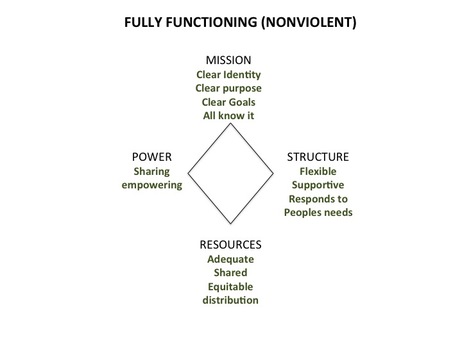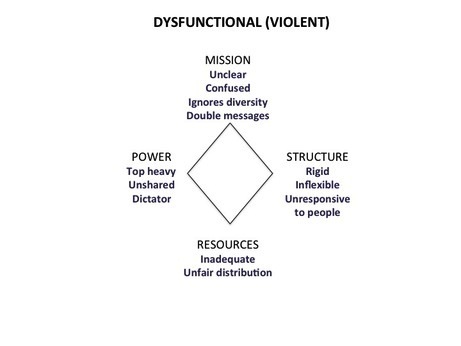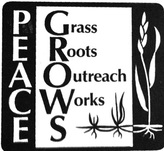Alternatives to Violence skills learned at the personal level have counterparts that apply to community problems.
Because consensus is vital to solving group problems, let's review by examining some pros and cons:
"MORE ABOUT THE CONSENSUS PROCESS":
|
What is good about consensus?
|
What is bad about consensus?
|
Let's move on to applying group roles, skills, and strategies to local community issues.
1. What is a good example of a community problem?
Did you think of any of the following... |
Examples include:
|
2. What skills are needed to solve community problems?
The following article may help focus our thoughts
"Applying Nonviolence to Solving Community Problems" Part 1
"At the community level, no one can do everything but, and this is the key, everyone can do something. When enough become engaged, then change takes place. Mainly we need the guidelines, the confidence and the will to act. This session seeks to motivate us in that direction."
This article was written by John Looney.
|
| ||
It took 75 years for the Women's Suffrage movement to grow from community to community until in 1920 women gained the Right to Vote in the USA.
Let's read and listen to a case study and video about one key female activist.
Case Study: |
WOMEN SUFFRAGISTS ASK:
|
"Alice Stokes Paul:
|
"Applying Nonviolence to Solving Community Problems", part 2
|
To break the cycle, there are certain key elements which can work to favor our success:
To achieve such results, the principles and skills taught in Alternatives to Violence are basic tools. As Arnold Toynbee, the famous historian once said, “The quest for alternatives to violence ought to be given the first place on 'humanity’s' crowded agenda. It should come first because it is the most urgent of all and is also the most difficult. It is urgent because . . . violence has become suicidal . . . . " This article was written by John Looney. |
| ||
The Civil Rights Movement started with small, but courageous, community actions and took decades to gain momentum. Here is a sample case of courage.
Case Study: |
BATTLE OF NERVES
|
|
In 1961 Leon Green, an eighteen year-old black university freshman, participated in a sit-in protesting segregation at an Atlanta lunch counter. He sat still and held the menu in both hands.
The enraged manager grabbed a meat cleaver and yelled, ”Get your hands off that counter or I'll cut off one of them.” He ripped the menu from Leon’s hands and raised the knife. Leon firmly held what was left of the menu and looked straight ahead. They both had a hard time during the next few seconds of silence. Then the manager turned and walked back to the kitchen to think it over. See The Quiet Battle (Sibley), pp. 291-299 and Courage in Both Hands (Hunter), pp. 84-85 |
Leon Green was no longer willing to accept the status quo and he attempted to break the cycle of acceptance by participating in the sit-in protest against segregation. The manager was then forced to think about his stance after his outburst against Leon shocked the manager into self reflection about what is right. Leon's act on a personal level was for the benefit of the larger community issue and an unjust society, harboring unshared power and unequal distribution of resources.
|
Try these community actions to address community problems named earlier in this session:
Here to move slide
We must always remember the following prerequisites of a just society. These qualities or features can reduce violence to a minimum and work for their own implementation.
What Makes a Society Just?
Theory and diagram by Robert Terry and Jean Alvarez.
Review and Reflect
Major Point to Remember:
Alternatives to Violence skills learned at the personal level have counterparts that apply to community problems.
To Reflect: Optional Activities
Materials located on the "Extra" page for applications #1 & #2
#1: Analyze at least two Case Studies: 13C, 13D, 13F
#2: Movie Assignment: View "Iron Jawed Angels" and answer the corresponding questions
#3: Application:
In a readership survey the strongest motivation for reading the editorial and opinion pages was “to feel I am participating in current events.” This was followed by “to keep up with the latest events,” “ to determine what is important,” “to use in discussions with my friends,” “to help me make decisions on issues,” “to strengthen my arguments on issues,” and “to help me form opinions about things going on around me.” The fact that reading the editorial page can be considered a form of participation in current events indicates its value as a forum for the public expression of ideas.
After reading this article, if you are not motivated to write to your hometown paper perhaps you will appreciate people who do write.
#2: Movie Assignment: View "Iron Jawed Angels" and answer the corresponding questions
#3: Application:
In a readership survey the strongest motivation for reading the editorial and opinion pages was “to feel I am participating in current events.” This was followed by “to keep up with the latest events,” “ to determine what is important,” “to use in discussions with my friends,” “to help me make decisions on issues,” “to strengthen my arguments on issues,” and “to help me form opinions about things going on around me.” The fact that reading the editorial page can be considered a form of participation in current events indicates its value as a forum for the public expression of ideas.
After reading this article, if you are not motivated to write to your hometown paper perhaps you will appreciate people who do write.
| How to Write a Letter to the Editor Download |



